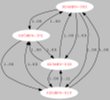|
It will depend on a lot of factors. For example: Local noise floor at each end. If one end is remote and has no noise then only the onboard receiver is the limit however if the remote node has lots of interference ( even from a single wifi device on the same property) this end would become the limiting factor for a link. Path the signal is taking: I once had a 20db SNR however we had a tree in the path so we would see the station and it would disappear for 10 seconds, return for 1 second and repeat (you can't see this on the simple interface ) Similar synptoms could occur from a bouncing signal. If the either end is moving in the wind this can affect the aim as well as the antennas blow out of line in the wind. Hardware at each end - diversity receive has a better chance to work than a single chain device. I have heard a report of a 20db dish with a bullet could be heard by a NanoStatiom 12 miles away, but the bullet couldn't hear the NanoStation. Put a NanoStatiom in place of the dish (a 10db reduction in antenna gain but an adding of a second polarity) and both sides could hear each other. the fact you are able to see the node is a good starter however. It may be as simple as a fee degrees of aiming required. I've heard stories where units were aimed towards a peak signal but it turned out to be a peak off one off the side lobe of antenna. And I've heard of cases where the peak was a bounce off of some surface and the antenna was getting a strong signal but because it was a bounce it would be unstable. Another fact that comes up is frensel zone. I've experianced this myself for the first time recently where 4 feet of extra height actually caused me to loose the signal. It can be counter intuitive but it does happen. So in the end there is no "this level is always guranteed to link" signal level.
|
